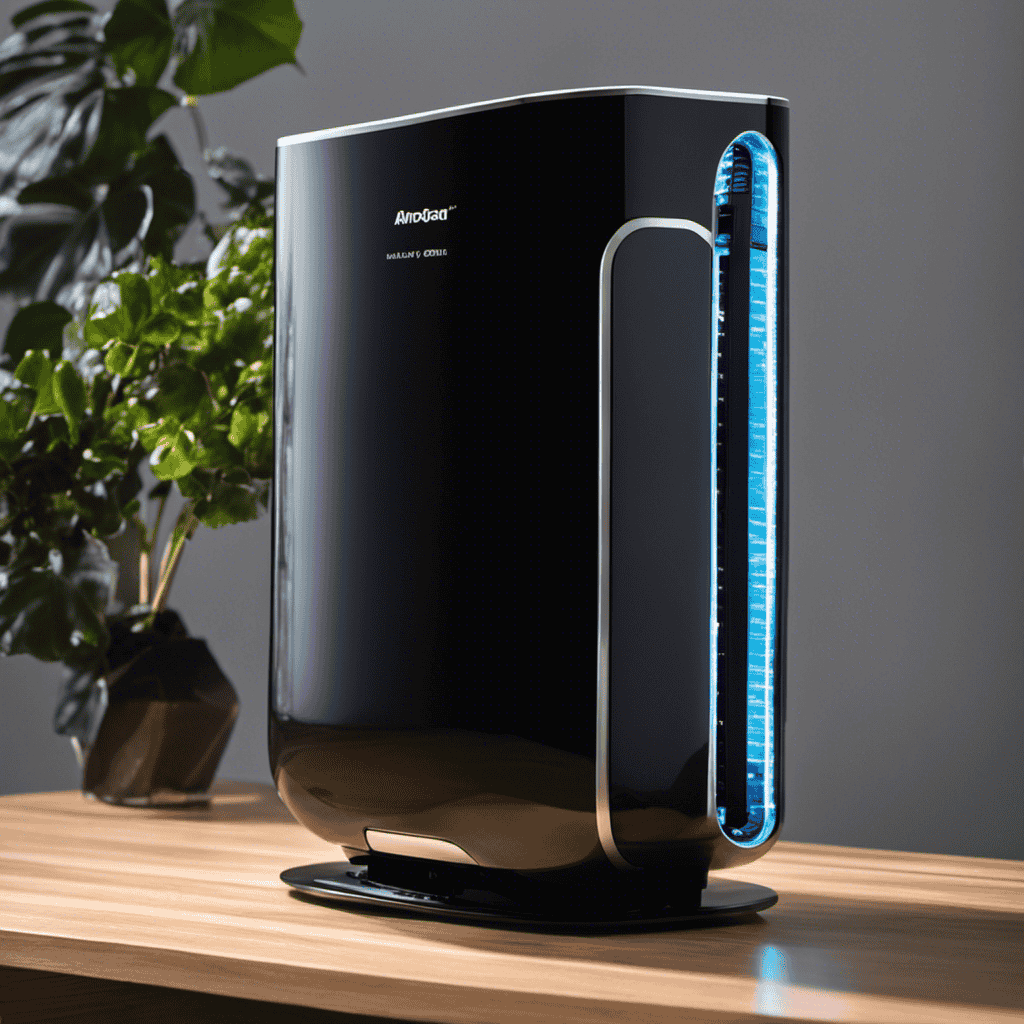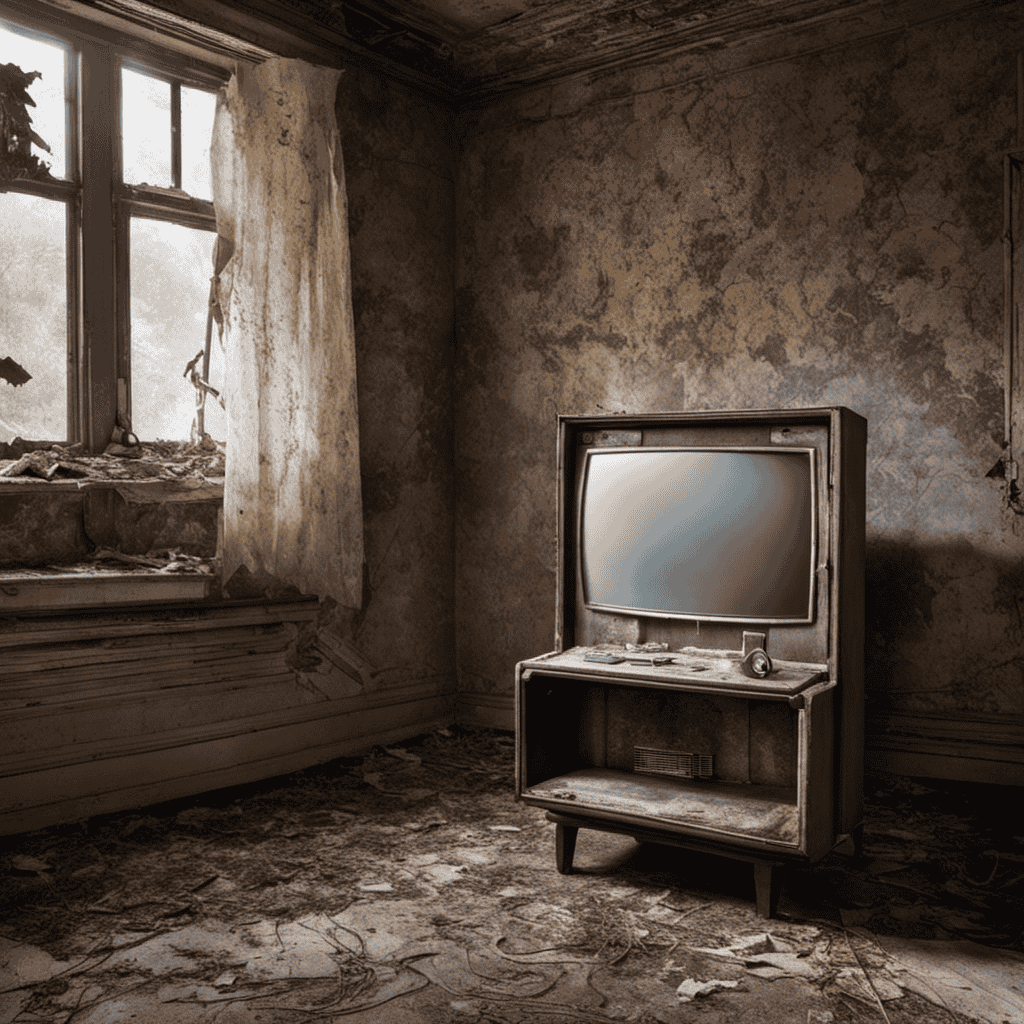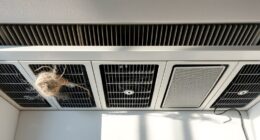As a owner of an air purifier, I frequently ponder, ‘How frequently should I clean my air purifier?’ It’s a common question that many of us have, and the answer may not be as simple as we expect.
Factors such as the air quality in your area, the type of air purifier you have, and your usage patterns can all impact the cleaning frequency.
In this article, I will provide you with a comprehensive guide to help you determine the optimal cleaning schedule for your air purifier. Let’s dive in and uncover the secrets to maintaining clean and efficient indoor air quality.
Key Takeaways
- Cleaning frequency of an air purifier should be based on factors such as air quality, presence of pets or smokers, type of air purifier, and usage patterns.
- Signs that indicate the need for cleaning your air purifier include foul odors, decreased air flow, compromised effectiveness, increased energy consumption, and release of trapped pollutants.
- It is important to follow a step-by-step guide for cleaning your air purifier and adhere to cleaning frequency recommendations provided by the manufacturer, considering factors like indoor air quality, filter type, and usage patterns.
- Regular cleaning of the air purifier has several benefits, including maintaining efficiency, prolonging the device’s lifespan, ensuring effective removal of pollutants, improving air quality, and reducing allergy symptoms.
Factors Affecting Cleaning Frequency
Factors like the air quality in your area and the presence of pets or smokers can affect how often you should clean your air purifier. These factors can contribute to the accumulation of dust, pet dander, and other pollutants in your air purifier’s filters.
When these filters become clogged, the effectiveness of your air purifier decreases, making it important to clean them regularly. Regular cleaning not only ensures that your air purifier is working at its best, but it also helps to maintain good indoor air quality. By removing the accumulated pollutants from the filters, you can breathe cleaner air and reduce the risk of respiratory issues.
Cleaning your air purifier regularly also helps to prolong its lifespan and prevent any potential damage. Understanding these factors affecting maintenance and the benefits of regular cleaning is essential for ensuring the optimal performance of your air purifier.
Now, let’s explore the signs that indicate your air purifier needs cleaning.
Signs That Your Air Purifier Needs Cleaning
When it comes to keeping my air purifier in top shape, there are a few key indicators I always look out for.
First, foul odors are a telltale sign that my air purifier needs cleaning. These unpleasant smells can indicate the buildup of dirt, dust, and other pollutants in the filters.
Additionally, decreased air flow is another clear indication that it’s time to clean my air purifier. When the air flow becomes restricted, it means the filters are clogged and not able to effectively remove particles from the air.
Foul Odors Indicate
If you start noticing foul odors coming from your air purifier, it’s time to clean it.
Regular maintenance is important for ensuring the optimal performance of your air purifier, as well as for maintaining a healthy indoor environment.
Air purifiers are designed to remove pollutants and allergens from the air, providing numerous benefits for your health. By trapping and eliminating airborne particles, they help reduce respiratory issues, such as allergies and asthma.
However, over time, these particles can accumulate in the filters, leading to the development of foul odors. Cleaning your air purifier regularly not only eliminates these odors but also ensures that the filters are free from clogs, allowing them to effectively remove pollutants from the air.
Decreased Air Flow
One possible paragraph structure:
A decrease in air flow may indicate that it’s time to check and clean the filters in your air purifier. Regular maintenance of your air purifier is crucial for its optimal performance and longevity. Cleaning the filters regularly ensures that the air purifier can effectively remove pollutants from the air. Neglecting to clean the filters can lead to a decrease in air flow, which compromises the purifier’s ability to clean the air. A decrease in air flow can also result in increased energy consumption as the purifier works harder to circulate air through clogged filters. Additionally, dirty filters can negatively impact air quality by releasing trapped pollutants back into the air. To maintain the efficiency of your air purifier and prevent a decrease in air flow, it is recommended to clean the filters every 3-6 months, or as recommended by the manufacturer. Regularly cleaning and replacing the filters will ensure that your air purifier continues to provide clean and fresh air for you and your family.
Step-by-Step Guide to Cleaning Your Air Purifier
Cleaning your air purifier regularly is essential for maintaining its effectiveness and ensuring clean air in your home.
According to experts, it is recommended to clean your air purifier at least once every two to three months, or more frequently if you have pets or live in a dusty environment.
Regular cleaning not only helps remove accumulated dust and debris, but it also prevents clogging and prolongs the lifespan of your air purifier.
To properly clean your air purifier, make sure to follow the manufacturer’s instructions, which typically involve vacuuming or washing the filters, wiping down the exterior, and checking for any signs of damage.
Cleaning Frequency Recommendations
To maintain optimal air quality, it is important to regularly clean your air purifier according to the manufacturer’s recommendations. The cleaning frequency can vary depending on several factors that affect the performance of your air purifier. These factors include indoor air quality, filter type, usage, and manufacturer recommendations.
Indoor air quality plays a significant role in determining how often you should clean your air purifier. If you live in an area with high pollution levels or have pets, you may need to clean your air purifier more frequently to ensure its effectiveness.
Different types of filters have different cleaning needs. Some filters can be vacuumed or washed, while others need to be replaced regularly. It is important to understand the specific cleaning requirements of your air purifier’s filter.
The usage of your air purifier also affects the cleaning frequency. If you use your air purifier for extended periods or in rooms with high levels of contaminants, it is recommended to clean it more often to maintain its performance.
Always refer to the manufacturer’s guidelines for cleaning frequency to ensure you are maintaining your air purifier properly. The manufacturer knows the specific requirements of their product and can provide the most accurate recommendations.
Regular cleaning of your air purifier offers several benefits. It improves air quality by removing dust, allergens, and pollutants from the air. This can help reduce allergy symptoms and respiratory issues. Additionally, regular cleaning prevents clogging and extends the life of the filters, increasing the lifespan of your air purifier. A clean air purifier also operates more efficiently, effectively removing harmful particles from the air and maintaining optimal indoor air quality. Lastly, regular maintenance and cleaning can help prevent costly repairs and replacements, resulting in cost savings.
Importance of Regular Cleaning
Make sure you regularly maintain your air purifier to ensure optimal performance and clean air in your home. Regular cleaning is important because it helps to remove accumulated dust, pollutants, and allergens from the air purifier’s filters.
The cleaning frequency depends on several factors. Firstly, the manufacturer’s recommendations should be followed. Some air purifiers may require monthly cleaning, while others may only need cleaning every three to six months. Additionally, factors such as the air quality in your home, the presence of pets, and the level of outdoor pollution can also affect the cleaning frequency.
Regular maintenance has several benefits. It helps to maintain the efficiency of the air purifier, allowing it to effectively remove pollutants from the air. It also prolongs the lifespan of the device, ensuring that it continues to provide you with clean and fresh air for a longer period of time.
Proper Cleaning Techniques
Regular maintenance is key to ensuring the optimal performance and longevity of your air purifier. Cleaning your air purifier on a regular basis is important to keep it running efficiently and effectively. Here are some cleaning frequency recommendations and common mistakes to avoid when cleaning your air purifier:
- Clean the pre-filter every 2-3 months to remove larger particles and prolong the life of the HEPA filter.
- Clean the HEPA filter every 6-12 months, depending on the manufacturer’s recommendations and the air quality in your area.
- Clean the carbon filter every 6-12 months to remove odors and chemicals from the air.
- Clean the air purifier’s exterior regularly with a damp cloth to remove dust and dirt buildup.
Common mistakes to avoid when cleaning your air purifier include using harsh chemicals, submerging the filters in water, and not allowing the filters to dry completely before reassembling the unit.
Recommended Cleaning Schedule for Different Types of Air Purifiers
The recommended cleaning schedule for different types of air purifiers varies. Factors affecting maintenance include the type of air purifier, the environment it is used in, and the level of air pollution.
It is important to follow the manufacturer’s instructions for cleaning and maintenance to ensure optimal performance. Regular cleaning helps to remove dust, allergens, and other particles from the filters, allowing the air purifier to effectively clean the air in your home.
A clean air purifier also prevents the buildup of bacteria and mold, which can negatively affect indoor air quality. By maintaining a clean air purifier, you can enjoy the benefits of improved air quality, such as reduced allergy symptoms, better respiratory health, and a cleaner living environment.
Common Mistakes to Avoid When Cleaning Your Air Purifier
When cleaning your air purifier, be careful not to use harsh chemicals that could damage the filters. It is important to maintain your air purifier regularly to ensure its optimal performance and longevity. Here are some common mistakes to avoid when cleaning your air purifier:
-
Neglecting to read the manufacturer’s instructions: Each air purifier may have specific cleaning instructions, so it is essential to follow them carefully.
-
Using excessive force: It is important to handle the air purifier with care to avoid damaging any delicate components or filters.
-
Skipping regular filter replacement: Filters are an integral part of an air purifier, and neglecting to replace them can hinder its effectiveness.
-
Forgetting to clean the pre-filter: The pre-filter captures larger particles and should be cleaned regularly to prevent clogging and prolong the life of the main filter.
Tips for Maintaining a Clean and Efficient Air Purifier
Now that we’ve discussed the common mistakes to avoid when cleaning your air purifier, let’s move on to some tips for maintaining a clean and efficient air purifier.
Proper maintenance is crucial to ensure that your air purifier functions optimally and continues to provide you with clean and fresh air.
Firstly, it’s important to regularly clean or replace the filters in your air purifier according to the manufacturer’s instructions. This will help to remove dust, allergens, and other particles from the air more effectively.
Additionally, using the right cleaning products is essential. Avoid using harsh chemicals or abrasive cleaners, as they can damage the components of your air purifier. Instead, opt for mild, non-toxic cleaning solutions or simply wipe the surface of the purifier with a damp cloth.
Importance of Regularly Cleaning Your Air Purifier
To maintain optimal performance and ensure the quality of the air you breathe, it’s crucial that you regularly clean and maintain your air purifier. Neglecting the maintenance of your air purifier can lead to a decrease in its effectiveness and potential health risks.
There are several factors that can affect the maintenance of your air purifier, including the type of filter used, the level of air pollution in your environment, and the frequency of use. Regular cleaning of your air purifier offers numerous benefits, including:
- Improved air quality: Cleaning your air purifier removes dust, allergens, and other pollutants, ensuring that the air you breathe is clean and healthy.
- Increased lifespan: Regular maintenance extends the lifespan of your air purifier, saving you money in the long run.
- Enhanced performance: A clean air purifier operates more efficiently, effectively removing pollutants from your environment.
- Reduced allergy symptoms: Regular maintenance reduces the buildup of allergens in your air purifier, helping to alleviate allergy symptoms.
Overall, regularly cleaning and maintaining your air purifier is essential for optimal performance and the benefits of clean air.
Frequently Asked Questions
Can I Clean My Air Purifier Too Often?
Yes, you can clean your air purifier too often. Overcleaning can damage the filters and reduce its effectiveness. It’s important to follow air purifier maintenance tips and look out for signs of a dirty air purifier to determine when cleaning is necessary.
What Happens if I Don’t Clean My Air Purifier Regularly?
If I neglect cleaning my air purifier regularly, the consequences can be dire. It won’t be as effective in removing pollutants, leading to poor indoor air quality and potential respiratory issues.
Should I Clean the Filters of My Air Purifier Separately or All at Once?
I clean my air purifier filters separately to ensure proper cleaning. It’s important to follow the manufacturer’s instructions for cleaning frequency and techniques to maintain optimal performance and indoor air quality.
Can I Use Any Type of Cleaning Solution to Clean My Air Purifier?
I wouldn’t recommend using just any cleaning solution on your air purifier. It’s best to follow the manufacturer’s guidelines for maintenance. Regular cleaning, using appropriate solutions, is crucial for optimal performance and longevity.
How Long Does It Typically Take to Clean an Air Purifier?
When cleaning my air purifier, I typically follow the manufacturer’s instructions. It’s important to clean it properly to maintain its efficiency. Here are some tips for maintaining your air purifier’s efficiency.
What is the recommended cleaning frequency for air purifiers in general?
When it comes to cleaning Honeywell air purifier, following a tutorial is essential for maintaining its effectiveness. The recommended cleaning frequency for air purifiers in general is every 3-6 months, but it may vary depending on usage and air quality. Following the cleaning Honeywell air purifier tutorial can ensure optimal performance.
Conclusion
In conclusion, keeping our air purifiers clean is essential for maintaining their effectiveness and ensuring the quality of the air we breathe.
Regular cleaning, as outlined in this article, helps to remove accumulated dirt, dust, and allergens, allowing the purifier to function optimally.
By following the recommended cleaning schedule and avoiding common mistakes, we can prolong the lifespan of our air purifiers and enjoy cleaner, fresher air.
Remember, a clean air purifier is like a breath of fresh air for your home.










